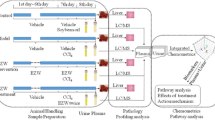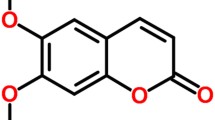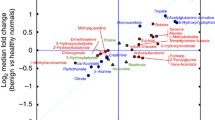Abstract
The primary objective of this study was to discover biomarkers which are correlated with hepatotoxicity induced by chemicals using 1H NMR spectral data of urine. A procedure of nuclear magnetic resonance (NMR) urinalysis using pattern recognition was proposed for early screening of the hepatotoxicity of CCl4, acetaminophen (AAP), and d-galactosamine (GalN) in rats. The hepatotoxic compounds were expected to induce necrosis in hepatocytes. This was confirmed through blood biochemistry and histopathology. CCl4 (1 ml/kg, po) or GalN (0.8 g/kg, ip) was single administered to Sprague–Dawley (S–D) rats and urine was collected every 24 h. Animals were sacrificed 24 h or 48 h post-dosing. AAP (2 g/kg, po) was administered for 2 days and then the animals were sacrificed 24 h after the last treatment. NMR spectroscopy revealed evidently different clustering between control groups and hepatotoxicant treatment groups in global metabolic profilings as indicated by partial least square (PLS)-discrimination analysis (DA). In targeted profilings, endogenous metabolites of allantoin, citrate, taurine, 2-oxoglutarate, acetate, lactate, phenylacetyl glycine, succinate, phenylacetate, 1-methylnicotinamide, hippurate, and benzoate were selected as putative biomarkers for hepatoxicity by CCl4, AAP, and GalN. Comparison of our rat 1H NMR PLS-DA data with histopathological changes suggests that 1H NMR urinalysis can be used to predict hepatotoxicity induced by CCl4, AAP, and GalN.











Similar content being viewed by others
References
Andringa, K. K., Bajt, M. L., Jaeschke, H., & Bailey, S. M. (2008). Mitochondrial protein thiol modifications in acetaminophen hepatotoxicity: Effect on HMG-CoA synthase. Toxicology Letters, 177, 188–197. doi:10.1016/j.toxlet.2008.01.010.
Ayonrinde, O. T., Phelps, G. J., Hurley, J. C., & Ayonrinde, O. A. (2005). Paracetamol overdose and hepatotoxicity at a regional Australian hospital: A 4-year experience. Internal Medicine Journal, 35, 655–660. doi:10.1111/j.1445-5994.2005.00947.x.
Beckwith-Hall, B. M., Nicholson, J. K., Nicholls, A. W., Foxall, P. J., Lindon, J. C., Connor, S. C., et al. (1998). Nuclear magnetic resonance spectroscopic and principal components analysis investigations into biochemical effects of three model hepatotoxins. Chemical Research in Toxicology, 11, 260–272. doi:10.1021/tx9700679.
Biour, M., Poupon, R., Grange, J. D., Chazouilleres, O., & Jaillon, P. (1998). Drug-induced hepatotoxicity. Eleventh update of the bibliographic database on liver injuries and responsible drugs. Gastroenterologie Clinique et Biologique, 22, 1004–1044.
Caldwell, G. W., Ritchie, D. M., Masucci, J. A., Hageman, W., & Yan, Z. (2001). The new pre-preclinical paradigm: compound optimization in early and late phase drug discovery. Current Topics in Medicinal Chemistry, 1, 353–366. doi:10.2174/1568026013394949.
Cavaluzzi, M. J., Kerwood, D. J., & Borer, P. N. (2002). Accurate nucleic acid concentrations by nuclear magnetic resonance. Analytical Biochemistry, 308, 373–380. doi:10.1016/S0003-2697(02)00262-2.
Chadha, V., Garg, U., & Alon, U. S. (2001). Measurement of urinary concentration: a critical appraisal of methodologies. Pediatric Nephrology (Berlin, Germany), 16, 374–382. doi:10.1007/s004670000551.
Clayton, T. A., Lindon, J. C., Cloarec, O., Antti, H., Charuel, C., Hanton, G., et al. (2006). Pharmaco-metabonomic phenotyping and personalized drug treatment. Nature, 440, 1073–1077. doi:10.1038/nature04648.
Coen, M., O’Sullivan, M., Bubb, W. A., Kuchel, P. W., & Sorrell, T. (2005). Proton nuclear magnetic resonance-based metabonomics for rapid diagnosis of meningitis and ventriculitis. Clinical Infectious Diseases, 41, 1582–1590. doi:10.1086/497836.
Constantinou, M. A., Theocharis, S. E., & Mikros, E. (2007). Application of metabonomics on an experimental model of fibrosis and cirrhosis induced by thioacetamide in rats. Toxicology and Applied Pharmacology, 218, 11–19. doi:10.1016/j.taap.2006.10.007.
Craig, A., Sidaway, J., Holmes, E., Orton, T., Jackson, D., Rowlinson, R., et al. (2006). Systems toxicology: Integrated genomic, proteomic and metabonomic analysis of methapyrilene induced hepatotoxicity in the rat. Journal of Proteome Research, 5, 1586–1601. doi:10.1021/pr0503376.
Crockford, D. J., Keun, H. C., Smith, L. M., Holmes, E., & Nicholson, J. K. (2005). Curve-fitting method for direct quantitation of compounds in complex biological mixtures using 1H NMR: Application in metabonomic toxicology studies. Analytical Chemistry, 77, 4556–4562. doi:10.1021/ac0503456.
Cuatrecasas, P. (2006). Drug discovery in jeopardy. The Journal of Clinical Investigation, 116, 2837–2842. doi:10.1172/JCI29999.
Duarte, I. F., Stanley, E. G., Holmes, E., Lindon, J. C., Gil, A. M., Tang, H., et al. (2005). Metabolic assessment of human liver transplants from biopsy samples at the donor and recipient stages using high-resolution magic angle spinning 1H NMR spectroscopy. Analytical Chemistry, 77, 5570–5578. doi:10.1021/ac050455c.
Dunn, W. B., Bailey, N. J., & Johnson, H. E. (2005). Measuring the metabolome: Current analytical technologies. Analyst (London), 130, 606–625. doi:10.1039/b418288j.
Ekins, S., Nikolsky, Y., & Nikolskaya, T. (2005). Techniques: application of systems biology to absorption, distribution, metabolism, excretion and toxicity. Trends in Pharmacological Sciences, 26, 202–209. doi:10.1016/j.tips.2005.02.006.
Fontana, R. J., & Quallich, L. G. (2001). Acute liver failure. Current Opinion in Gastroenterology, 17, 291–298. doi:10.1097/00001574-200105000-00013.
Fukushima, T., Kikkawa, R., Hamada, Y., & Horii, I. (2006). Genomic cluster and network analysis for predictive screening for hepatotoxicity. The Journal of Toxicological Sciences, 31, 419–432. doi:10.2131/jts.31.419.
Fung, M., Thornton, A., Mybeck, K., Wu, J. H., Hornbuckle, K., & Muniz, E. (2001). Evaluation of the characteristics of safety withdrawal of prescription drugs from worldwide pharmaceutical markets-1960 to 1999. Drug Information Journal, 35, 293–317.
Gatley, S. J., & Sherratt, H. S. (1977). The synthesis of hippurate from benzoate and glycine by rat liver mitochondria. Submitochondrial localization and kinetics. The Biochemical Journal, 166, 39–47.
Gavaghan, C. L., Wilson, I. D., & Nicholson, J. K. (2002). Physiological variation in metabolic phenotyping and functional genomic studies: Use of orthogonal signal correction and PLS-DA. FEBS Letters, 530, 191–196. doi:10.1016/S0014-5793(02)03476-2.
Griffin, J. L., Scott, J., & Nicholson, J. K. (2007). The influence of pharmacogenetics on fatty liver disease in the wistar and kyoto rats: A combined transcriptomic and metabonomic study. Journal of Proteome Research, 6, 54–61. doi:10.1021/pr0601640.
Holmes, E., Nicholls, A. W., Lindon, J. C., Ramos, S., Spraul, M., Neidig, P., et al. (1998). Development of a model for classification of toxin-induced lesions using 1H NMR spectroscopy of urine combined with pattern recognition. NMR in Biomedicine, 11, 235–244. doi:10.1002/(SICI)1099-1492(199806/08)11:4/5<235::AID-NBM507>3.0.CO;2-V.
Kaplowitz, N. (2001). Drug-induced liver disorders: implications for drug development and regulation. Drug Safety, 24, 483–490. doi:10.2165/00002018-200124070-00001.
Keller, N. P., Turner, G., & Bennett, J. W. (2005). Fungal secondary metabolism—from biochemistry to genomics. Nature Reviews Microbiology, 3, 937–947. doi:10.1038/nrmicro1286.
Keun, H. C., Ebbels, T. M., Antti, H., Bollard, M. E., Beckonert, O., Schlotterbeck, G., et al. (2002). Analytical reproducibility in (1)H NMR-based metabonomic urinalysis. Chemical Research in Toxicology, 15, 1380–1386. doi:10.1021/tx0255774.
Knodell, R. G., Ishak, K. G., Black, W. C., Chen, T. S., Craig, R., Kaplowitz, N., et al. (1981). Formulation and application of a numerical scoring system for assessing histological activity in asymptomatic chronic active hepatitis. Hepatology (Baltimore, Md.), 1, 431–435. doi:10.1002/hep.1840010511.
Kuwahata, M., Tomoe, Y., Harada, N., Amano, S., Segawa, H., Tatsumi, S., et al. (2007). Characterization of the molecular mechanisms involved in the increased insulin secretion in rats with acute liver failure. Biochimica et Biophysica Acta, 1772, 60–65.
Lindon, J. C., Holmes, E., Bollard, M. E., Stanley, E. G., & Nicholson, J. K. (2004). Metabonomics technologies and their applications in physiological monitoring, drug safety assessment and disease diagnosis. Biomarkers, 9, 1–31. doi:10.1080/13547500410001668379.
Llinares Tello, F., Hernandez Prats, C., Bosacoma Ros, N., Perez Martinez, E., Climent Grana, E., Navarro Polo, J. N., et al. (2005). Acute cholestatic hepatitis probably associated with risperidone. International Journal of Psychiatry in Medicine, 35, 199–205. doi:10.2190/5XRB-D2XX-X8AH-32KB.
Megli, F. M., & Sabatini, K. (2004). Mitochondrial phospholipid bilayer structure is ruined after liver oxidative injury in vivo. FEBS Letters, 573, 68–72. doi:10.1016/j.febslet.2004.07.057.
Nicholson, J. K., Lindon, J. C., & Holmes, E. (1999). ‘Metabonomics’: understanding the metabolic responses of living systems to pathophysiological stimuli via multivariate statistical analysis of biological NMR spectroscopic data. Xenobiotica, 29, 1181–1189. doi:10.1080/004982599238047.
Petterino, C., & Argentino-Storino, A. (2006). Clinical chemistry and haematology historical data in control Sprague–Dawley rats from pre-clinical toxicity studies. Experimental and Toxicologic Pathology, 57, 213–219. doi:10.1016/j.etp.2005.10.002.
Rastall, R. A., Gibson, G. R., Gill, H. S., Guarner, F., Klaenhammer, T. R., Pot, B., et al. (2005). Modulation of the microbial ecology of the human colon by probiotics, prebiotics and synbiotics to enhance human health: an overview of enabling science and potential applications. FEMS Microbiology Ecology, 52, 145–152. doi:10.1016/j.femsec.2005.01.003.
Robertson, D. G., Reily, M. D., & Baker, J. D. (2005). Metabonomics in preclinical drug development. Expert Opinion on Drug Metabolism & Toxicology, 1, 363–376. doi:10.1517/17425255.1.3.363.
Robertson, D. G., Reily, M. D., Sigler, R. E., Wells, D. F., Paterson, D. A., & Braden, T. K. (2000). Metabonomics: Evaluation of nuclear magnetic resonance (NMR) and pattern recognition technology for rapid in vivo screening of liver and kidney toxicants. Toxicological Sciences, 57, 326–337. doi:10.1093/toxsci/57.2.326.
Sanins, S. M., Nicholson, J. K., Elcombe, C., & Timbrell, J. A. (1990). Hepatotoxin-induced hypertaurinuria: A proton NMR study. Archives of Toxicology, 64, 407–411. doi:10.1007/BF01973464.
Schnackenberg, L. K., Dragan, Y. P., Reily, M. D., Robertson, D. G., & Beger, R. D. (2007). Evaluation of NMR spectral data of urine in conjunction with measured clinical chemistry and histopathology parameters to assess the effects of liver and kidney toxicants. Metabolomics, 3, 87–100. doi:10.1007/s11306-006-0046-y.
Schoonen, W. G., Kloks, C. P., Ploemen, J. P., Horbach, G. J., Smit, M. J., Zandberg, P., et al. (2007). Sensitivity of (1)H NMR analysis of rat urine in relation to toxicometabonomics. Part I: dose-dependent toxic effects of bromobenzene and paracetamol. Toxicological Sciences, 98, 271–285. doi:10.1093/toxsci/kfm076.
Schuster, M. A., McGlynn, E. A., & Brook, R. H. (2005). How good is the quality of health care in the United States? 1998. The Milbank Quarterly, 83, 843–895. doi:10.1111/j.1468-0009.2005.00403.x.
Smith, D. A., & Schmid, E. F. (2006). Drug withdrawals and the lessons within. Current Opinion in Drug Discovery & Development, 9, 38–46.
Sprague, G. F., Cullen, P. J., & Goehring, A. S. (2004). Yeast signal transduction: Regulation and interface with cell biology. Advances in Experimental Medicine and Biology, 547, 91–105.
Stoyanova, R., & Brown, T. R. (2001). NMR spectral quantitation by principal component analysis. NMR in Biomedicine, 14, 271–277. doi:10.1002/nbm.700.
Sun, J., Schnackenberg, L. K., Holland, R. D., Schmitt, T. C., Cantor, G. H., Dragan, Y. P., & Beger, R. D. (2008). Metabonomics evaluation of urine from rats given acute and chronic doses of acetaminophen using NMR and UPLC/MS. Journal of Chromatography B. doi: 10.1016/j.jchromb2008.04.008.
Tate, A. R., Damment, S. J., & Lindon, J. C. (2001). Investigation of the metabolite variation in control rat urine using (1)H NMR spectroscopy. Analytical Biochemistry, 291, 17–26. doi:10.1006/abio.2001.5008.
Vickers, A. E., & Fisher, R. L. (2004). Organ slices for the evaluation of human drug toxicity. Chemico-Biological Interactions, 150, 87–96. doi:10.1016/j.cbi.2004.09.005.
Waters, N. J., Holmes, E., Williams, A., Waterfield, C. J., Farrant, R. D., & Nicholson, J. K. (2001). NMR and pattern recognition studies on the time-related metabolic effects of alpha-naphthylisothiocyanate on liver, urine, and plasma in the rat: an integrative metabonomic approach. Chemical Research in Toxicology, 14, 1401–1412. doi:10.1021/tx010067f.
Wills, P. J., Suresh, V., Arun, M., & Asha, V. V. (2006). Antiangiogenic effect of Lygodium flexuosum against N-nitrosodiethylamine-induced hepatotoxicity in rats. Chemico-Biological Interactions, 164, 25–38. doi:10.1016/j.cbi.2006.08.021.
Wilson, I. D., Plumb, R., Granger, J., Major, H., Williams, R., & Lenz, E. M. (2005). HPLC-MS-based methods for the study of metabonomics. Journal of Chromatography B, Analytical Technologies in the Biomedical and Life Sciences, 817, 67–76. doi:10.1016/j.jchromb.2004.07.045.
Xu, J., & Purcell, W. M. (2006). Energy metabolism and biotransformation as endpoints to pre-screen hepatotoxicity using a liver spheroid model. Toxicology and Applied Pharmacology, 216, 293–302.
Yavuz, A., Tetta, C., Ersoy, F. F., D’intini, V., Ratanarat, R., De Cal, M., et al. (2005). Uremic toxins: A new focus on an old subject. Seminars in Dialysis, 18, 203–211. doi:10.1111/j.1525-139X.2005.18313.x.
Acknowledgments
This research was supported by a grant (07151KFDA626) from Korea Food & Drug Administration in 2007. The authors thank Dr. Geum-Sook Hwang for technical assistance of NMR urinalysis at Korea Basic Science Institute (Seoul, Korea).
Author information
Authors and Affiliations
Corresponding author
Rights and permissions
About this article
Cite this article
Kim, KB., Chung, M.W., Um, S.Y. et al. Metabolomics and biomarker discovery: NMR spectral data of urine and hepatotoxicity by carbon tetrachloride, acetaminophen, and d-galactosamine in rats. Metabolomics 4, 377–392 (2008). https://doi.org/10.1007/s11306-008-0131-5
Received:
Accepted:
Published:
Issue Date:
DOI: https://doi.org/10.1007/s11306-008-0131-5




